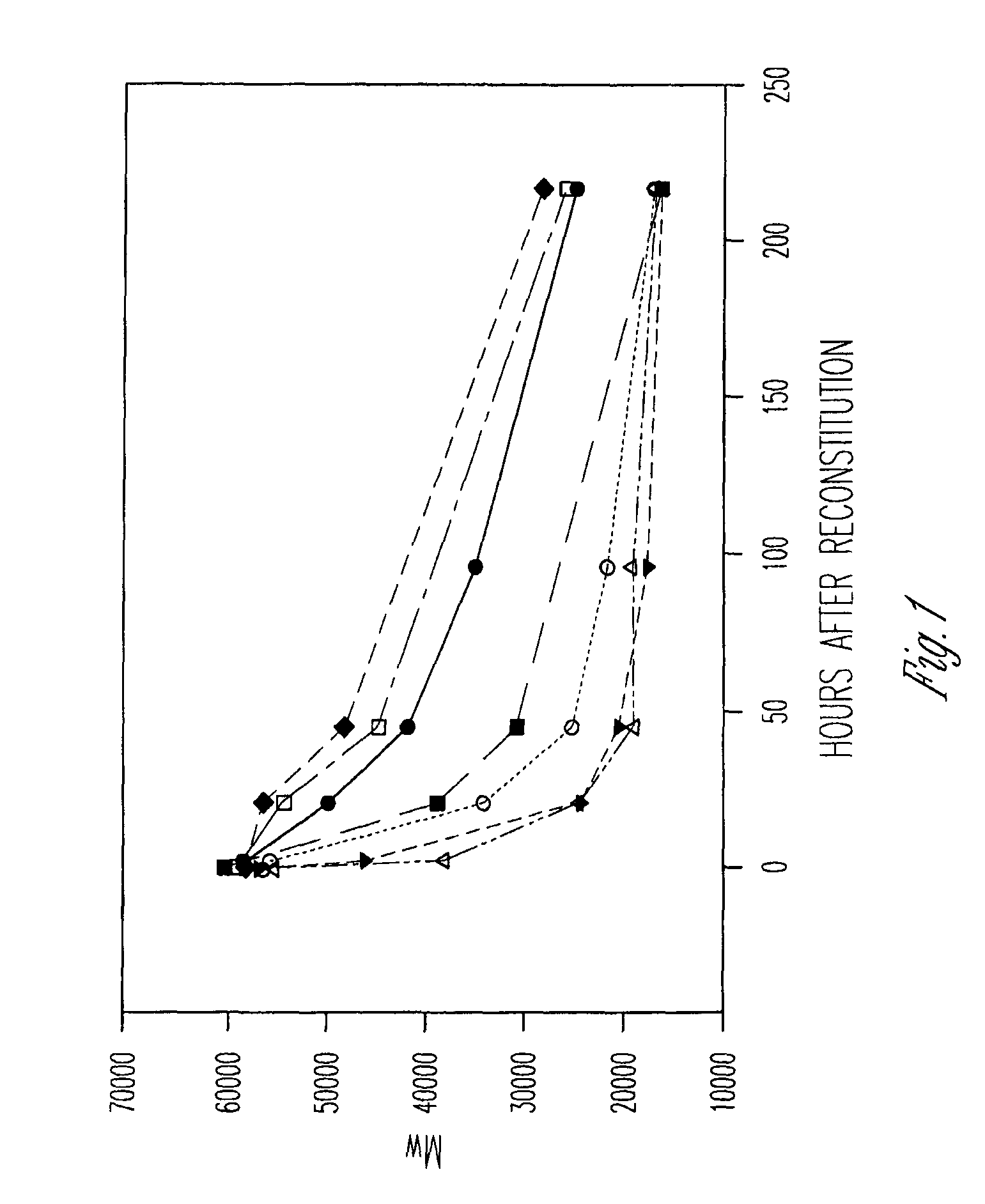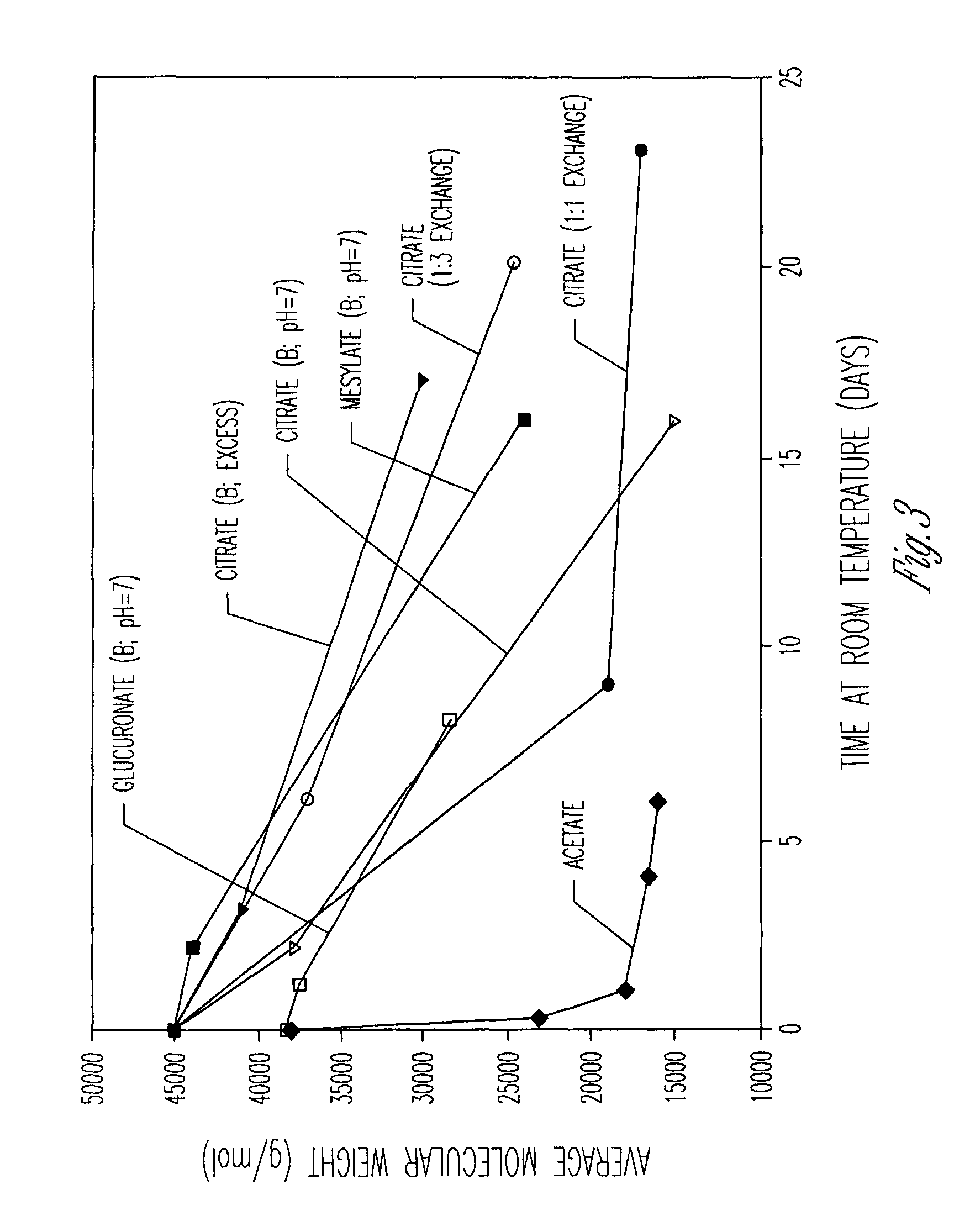Stabilized polymeric delivery system comprising a water-insoluble polymer and an organic liquid
a delivery system and water-soluble polymer technology, applied in the field of delivery systems, can solve the problems of easy dispersibility, easy dispersibility, and increased susceptibility to surgical procedures, and achieve the effects of reducing susceptibility, avoiding dispersion, and avoiding dispersion
- Summary
- Abstract
- Description
- Claims
- Application Information
AI Technical Summary
Benefits of technology
Problems solved by technology
Method used
Image
Examples
example 1
PLGH / NMP / Ocreotide Acetate / Citrate, Excess
[0285]The following composition was prepared. The composition was prepared to be dispensed as a two syringe, A / B product configuration. Syringe A (1.2 cc) contained about 244 mg of a solution composed of 37% by weight poly(lactide-co-glycolide) (PLG) with a lactide to glycolide ratio of 50 / 50 and with an inherent viscosity of 0.35 dL / g dissolved in 63% by weight N-methyl-2-pyrrolidone. Syringe B (1.2 cc) contained 30 mg of octreotide acetate / citrate combined with 6.8 mg of citric acid. The octreotide acetate / citrate is expressed as the amount of active peptide. The syringe B material was formed by dissolving the octreotide as octreotide acetate in water and then adding the citric acid to dissolve. The resulting solution was then filled into a syringe and the contents were lyophilized.
[0286]Prior to injection into a test organism, Syringe A and Syringe B were coupled and the final composition was constituted by expressing the contents of Syri...
example 2
PLGH / NMP / Octreotide Citrate 1:1
[0288]The following composition was prepared. As in example 1 the composition is dispensed as a two syringe, A / B product configuration. Syringe A contained a solution composed of 50% by weight of poly(lactide-co-glycolide) (PLGH) with a lactide to glycolide ratio of 85 / 15 and with an inherent viscosity of 0.25 dL / g dissolved in 50% by weight N-methyl-2-pyrrolidone. Syringe B contained octreotide combined with citric acid in a molar ratio of 1:1. The syringe B material was formed by dissolving the octreotide as octreotide acetate in water and then adding the citric acid to dissolve. The resulting solution was then filled into a syringe and the contents were lyophilized to remove the water and acetic acid.
[0289]The syringes were coupled as in example 1 and the contents cycled to form the composition for injection. The composition contained octreotide at a concentration of 12% by weight. Corrected for active purity of the peptide, the solution contained a...
example 3
PLGH / NMP / GHRP-1 / Citrate
[0291]The following composition was prepared. The polymer solution was composed of 50% by weight of poly(lactide-co-glycolide) (PLGH) with a lactide to glycolide ratio of 75 / 25 and with an inherent viscosity of 0.20 dL / g dissolved in 50% by weight N-methyl-2-pyrrolidone. The active portion was composed of GHRP-1 and citric acid. The ratio of citric acid to GHRP-1 was about 1.25:1 on a molar basis. The GHRP-1 was dissolved in water; citric acid was added to dissolve; and the solution was filled into a syringe and lyophilized. The contents of the completed syringe were about 80 mg of GHRP-1 and about 20 mg of citric acid.
[0292]For administration to a test subject, approximately 0.8 ml of composition was compounded. Syringe A containing the polymer solution was coupled with syringe B containing the GHRP-1, and the contents were cycled between the syringes to form a uniform composition. The completed composition contained GHRP-1 at a concentration of 100 mg / ml exp...
PUM
| Property | Measurement | Unit |
|---|---|---|
| diameters | aaaaa | aaaaa |
| volume | aaaaa | aaaaa |
| molecular weight | aaaaa | aaaaa |
Abstract
Description
Claims
Application Information
 Login to View More
Login to View More - R&D
- Intellectual Property
- Life Sciences
- Materials
- Tech Scout
- Unparalleled Data Quality
- Higher Quality Content
- 60% Fewer Hallucinations
Browse by: Latest US Patents, China's latest patents, Technical Efficacy Thesaurus, Application Domain, Technology Topic, Popular Technical Reports.
© 2025 PatSnap. All rights reserved.Legal|Privacy policy|Modern Slavery Act Transparency Statement|Sitemap|About US| Contact US: help@patsnap.com



